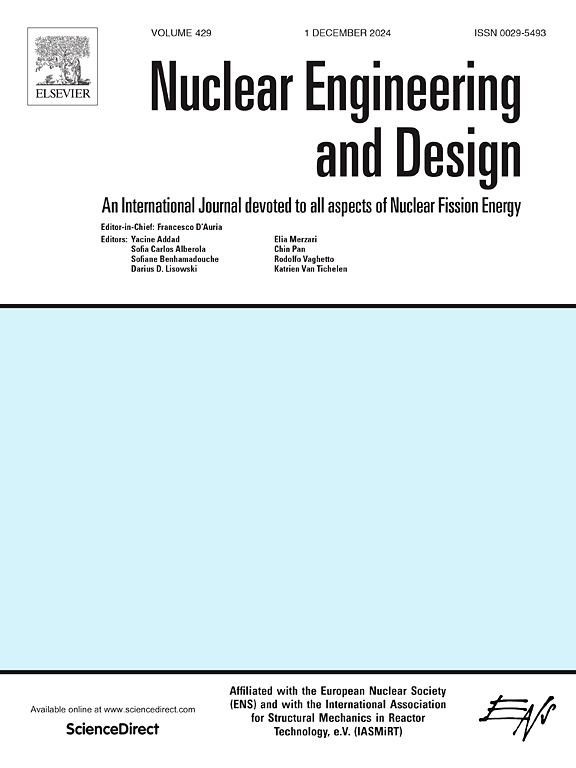Evaluation of core degradation and relocation before and after water injection in the LOFT experiment LP-FP-2
IF 1.9
3区 工程技术
Q1 NUCLEAR SCIENCE & TECHNOLOGY
引用次数: 0
Abstract
We used MAAP5 to examine the fuel cladding temperature, hydrogen generation amount and flow area distribution of the LOFT Experiment LP-FP-2. We confirmed that the computed cladding temperature and hydrogen generation amount became close to their measured values when the heat transfer degradation and cladding oxide film spalling that occurred immediately after the water injection were considered. Furthermore, the computed flow area distribution in the height direction approached the measured value if the time for fuel bundle collapse was estimated with the Larson-Miller parameter without the minimum time limit in MAAP5.
After confirming the applicability of MAAP5 to the LOFT Experiment LP-FP-2, we clarified the hydrogen flow rate and the fuel material relocation before and after the water injection. We found that UO2 relocated from the upper to the middle heated region after the water injection. On the other hand, the U-Zr-O mixture relocated to the lower heated region before the water injection and its mass increased after the water injection. Furthermore, we also found that the Ag-In-Cd of the control rods relocated to the lower heated region adjacent to the lower unheated region before the water injection.
LOFT实验中注水前后岩心降解和重定位的评价
我们使用MAAP5对LOFT实验LP-FP-2的燃料包壳温度、产氢量和流面积分布进行了研究。我们证实,当考虑注水后立即发生的传热退化和包层氧化膜剥落时,计算得到的包层温度和产氢量与实测值接近。此外,如果在MAAP5中不考虑最小时间限制,使用Larson-Miller参数估计燃料束坍塌时间,计算得到的高度方向流面积分布接近实测值。在确定了MAAP5对LOFT实验LP-FP-2的适用性后,我们明确了注水前后氢气流速和燃料材料迁移。我们发现注水后UO2由上热区向中热区迁移。另一方面,注水前U-Zr-O混合物向下受热区迁移,注水后其质量增加。此外,我们还发现,在注水前,控制棒的Ag-In-Cd迁移到靠近较低未加热区域的较低加热区域。
本文章由计算机程序翻译,如有差异,请以英文原文为准。
求助全文
约1分钟内获得全文
求助全文
来源期刊

Nuclear Engineering and Design
工程技术-核科学技术
CiteScore
3.40
自引率
11.80%
发文量
377
审稿时长
5 months
期刊介绍:
Nuclear Engineering and Design covers the wide range of disciplines involved in the engineering, design, safety and construction of nuclear fission reactors. The Editors welcome papers both on applied and innovative aspects and developments in nuclear science and technology.
Fundamentals of Reactor Design include:
• Thermal-Hydraulics and Core Physics
• Safety Analysis, Risk Assessment (PSA)
• Structural and Mechanical Engineering
• Materials Science
• Fuel Behavior and Design
• Structural Plant Design
• Engineering of Reactor Components
• Experiments
Aspects beyond fundamentals of Reactor Design covered:
• Accident Mitigation Measures
• Reactor Control Systems
• Licensing Issues
• Safeguard Engineering
• Economy of Plants
• Reprocessing / Waste Disposal
• Applications of Nuclear Energy
• Maintenance
• Decommissioning
Papers on new reactor ideas and developments (Generation IV reactors) such as inherently safe modular HTRs, High Performance LWRs/HWRs and LMFBs/GFR will be considered; Actinide Burners, Accelerator Driven Systems, Energy Amplifiers and other special designs of power and research reactors and their applications are also encouraged.
 求助内容:
求助内容: 应助结果提醒方式:
应助结果提醒方式:


